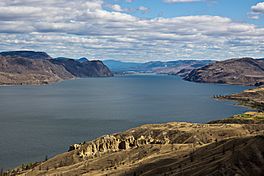Kamloops Lake facts for kids
Quick facts for kids Kamloops Lake |
|
|---|---|
 |
|
| Location | British Columbia |
| Coordinates | 50°45′N 120°40′W / 50.750°N 120.667°W |
| Primary inflows | Thompson River, Tranquille River |
| Primary outflows | Thompson River |
| Catchment area | 39,050 km2 (15,080 sq mi) |
| Basin countries | Canada |
| Max. length | 29 km (18 mi) |
| Max. width | 1.6 km (0.99 mi) |
| Surface area | 52 km2 (20 sq mi) |
| Average depth | 71 m (233 ft) |
| Max. depth | 152 m (499 ft) |
| Water volume | 3.7 km3 (3,000,000 acre⋅ft) |
| Residence time | ca. 0.2 years (20-340 days) |
| Shore length1 | 60.5 km (37.6 mi) |
| Surface elevation | 335 m (1,099 ft) |
| Settlements | Savona |
| 1 Shore length is not a well-defined measure. | |
Kamloops Lake is a large lake in British Columbia, Canada. It sits on the Thompson River, just west of the city of Kamloops. The lake is about 1.6 kilometers (1 mile) wide, 29 kilometers (18 miles) long, and can be as deep as 152 meters (500 feet). The small town of Savona is located at the western end of the lake. The city of Kamloops is a bit further east, where the North and South Thompson Rivers meet.
The land around Kamloops Lake is mostly steep hillsides. You'll only find flat areas near the mouths of creeks or where the river enters and leaves the lake. Most of the land nearby is not lived on. This area is known for its dry grasslands, with plants like bunchgrass and sagebrush. You can also find groups of Douglas fir, Ponderosa pine, and spruce trees.
Contents
How Kamloops Lake Works
Kamloops Lake is shaped by the Thompson River. The river flows into the east end of the lake and exits at the west end. The amount of water flowing into the lake changes a lot throughout the year. More than 60% of the water enters in early summer, from May to July. This time is called the freshet, when snow and ice melt and cause river levels to rise.
Water Levels and Flow
During the freshet, the lake's water levels can naturally rise as much as 9 meters (30 feet). This happens between the high water season in June and the low water season. After the freshet, as water levels go down, beach areas can expand by as much as 60 meters (200 feet).
The water in Kamloops Lake gets replaced quite quickly. It takes anywhere from 20 to 340 days for all the water in the lake to be swapped out for new water. On average, this happens every 60 days.
Why Kamloops Lake is Warm
Kamloops Lake gets its water from both the North and South Thompson rivers. The South Thompson River flows from the very warm Shuswap Lakes. Because of this, Kamloops Lake is a very warm lake, which makes it great for swimming and boating.
Fun Activities on Kamloops Lake
Since the late 1900s, Kamloops Lake has become a very popular spot for boating and other water activities. On the north side of the lake, you'll find an area called Fredrick. On the south side, there are neighborhoods like Cherry Creek and the Tobiano resort community.
Tobiano has special facilities for boaters, including a boat launch, a long dock, and a gas station for boats. It's the only place on Kamloops Lake with all these services. Both Savona and Kamloops also have boat launches. However, it can be harder to use them in the late summer when the water levels are lower.
Lake Measurements
- Water level: Not controlled by dams or other structures.
- Normal yearly water level change: About 5 meters (16 feet).
- Surface height above sea level: 335 meters (1,099 feet).



